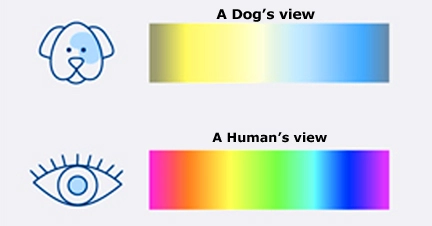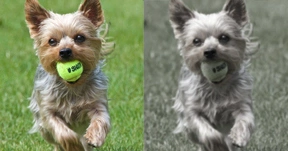Rainbow’s birthday is close and you are storming the internet to shop for some toys and tees for him. After hours of hunting, you finally pick a bright, colorful ball and a red tshirt but can Rainbow see the colors in the ball or the redness of the tee? Precisely, can dogs see colors? If yes, then which colors do dogs see? And, eventually, how do dogs see colors?
I’ll answer all these questions but before that let me address the myth we all knew about dogs and colors.
Just like you, in my childhood I had heard that dogs can only see black and white. But watching my dog chase after a bright green ball I used to wonder do dogs see in colors or black and white?
This article will answer various questions like can dogs see colors, what colors can dogs see, how do dogs see colors, and many more.
But before we dive into the world of dogs and colors, first we need to understand colors in general and how humans see colors.
Table of Contents
What makes colors so “colorful?”
Let’s imagine a colorful beach ball! If we notice all the colors on the beach ball, we know that they come from different paints in the plastic ball.
We have also studied that light is made up of different wavelengths or colors. Also, white light is a combination of all of the colors.
For this reason, when a ray of sunshine falls on a part of the beach ball, the paint absorbs most of the colors and reflects the rest which are eventually visible to us.
For instance, if the patch is red, it reflects the red wavelengths and absorbs all the others colors.
When the reflected color from the Sun bounces off the beach ball, right into your eye, that’s exactly when all the action takes place.
In the eye, color is detected by the nerve cells. At the rear end of your eye is a tissue called the retina. Here, there are two main types of cells — rods and cones.
Rods are the cells responsible to detect motion and light levels, and cones help us to tell the difference in colors. The human eye has three types of cones and these three kinds of cones can identify and distinguish combinations of red, blue, and green colors.
On the other hand, dogs have only two types of cones and can only identify blue, yellow, and some shades of grey. This feature of a limited visual perception is broadly known as dichromatic vision.
Because humans may have more cones, it allows us to see more colors and shades, and also see them brighter than what dogs see.
But dogs have more rods compared to humans and this gives them the power to see in low light and the ability to identify moving objects.
Also read – Top 10 Indian breeds of dogs I Bet You Didn’t Know About
What is color blindness?
It is known that in the late 18th century an English scientist named John Dalton carried out the first research and studies on congenital color blindness.
Sir Dalton had become aware of the phenomenon when he noticed that he and his brother could not recognize certain colors. Briefly, they confused the color ‘pink’ with blue, and ‘scarlet’ with green.
After many years of research, it was found that the defect in red-green perception is the most common form of color deficiency in humans. Findings say that almost 8 percent of men and 0.5 percent of women who possess a Northern European ancestry tend to have red-green color blindness.
Typically, color blindness happens due to deformities in the cones which are the color-detecting particles in the retina. People who lack some of these color-detecting particles are unable to identify certain light wavelengths. This is the reason why some people are color blind.
However, color-blind people can actually can make out certain colors. For example, people with red-green color-blindness can still understand yellow and blue, but objects in red will look grey or brown to them.
Are dogs color blind ?
Studies and analysis of the canine eye structure conducted during the last few decades have revealed some differences between the human eye and the dog eye.
Dog biological evolution and life roles have led to these differences.
Evidently, like their wolf ancestors, dogs cultivated their senses as nocturnal hunters with the purpose of hunting, tracking and catching their food at night. Therefore, their eyes adjusted to the low-light vision and adapted to see well in the dark as well as to catch movement.
Dr. Jerry Klein, chief veterinary officer at AKC explains, “Canine eyes have more rods, a larger lens and larger eyeballs, and a reflective membrane, known as tapetum lucidum, that enhances night-vision in the retina”.
With numerous investigations, scientists have also found that the retina is the key to the difference in color perception between dogs and humans.
Like discussed earlier, the retina is composed of millions of extremely sensitive light-sensing cells(rods) that catch movement and work in low light, and cones that help understand and differentiate colors.
As a result of the findings, canine researchers concluded that dogs have more rods than cones in their retina, whereas humans have more cones. Apparently, this outcome makes the difference in color sense of dogs and humans.
Dogs are dichromatic, which means they have only two types of cones and human beings, along with a few other primate species are trichromatic, which means they have three kinds of cones.
Each type of cone is responsible to sense a different color. The cone in charge of ‘red and green’ helps us to recognize the valentine red rose or a green Granny Smith apple.
On the other hand, like certain color-blind people, dogs do not have the red-green cones. So, this means that dogs are not color-blind, they are just spectrum challenged.
Meanwhile, there are some types of fish and birds that are tetra chromatic which means they have a fourth cone receptor to absorb ultraviolet light. These tetra chromatic creatures can see a broader range of the colors than what we normal can.
Also read – Do dogs get tired of barking ? Let’s find out the answer here
Can dogs see colors ?
Yes, for a short answer. But not like you do.
While researching what colors dogs can see, I managed to find that dogs indeed can see colors. However, they don’t view colors the same way humans do
For instance, the rainbow to us is a variation of colors including violet, indigo, blue, green, yellow, orange and red. But a dog can only identify the blue and yellow color in the rainbow.
So your dog would see a rainbow as dark yellow or brown, light yellow, a shade of gray, light blue, and dark blue.
What colors can dogs see?
While we can’t ask dogs to read a color-chart, behavioural examinations have contributed in understanding the color perception of dogs.
Research tests show that dogs can’t take in as many colors as we can, but this does not mean that their world is black and white. Dogs can see blue, yellow, and shades of combination of these two colors. They can also see certain hues of gray.
Also read – Border Collie – The most intelligent dog breed in the world
What colors can dogs not see?
Canine experiments reveal that dogs don’t see red, violet, or orange the way humans do.
So, while it is true that dogs see shades of yellow, blue, and gray, and for instance, if a dog looks at an apple that is red or green, it would appear as faded brownish, gray, or blur.
Take a look at the color chart below to get an idea of how do dogs see colors.

How do dogs see colors ?
While researching how do dogs see colors, canine experts have come up with a dog color spectrum in reference to the human color spectrum.
One can easily see that dogs don’t appreciate the entire spectrum of color that humans do, but that does not mean they are unable to identify different hues.
When you take a look at the dog-view of an object, you will notice that they just may not see the “true” color of an object.
For instance, in the case of a red Frisbee, it will appear dark brownish-gray or black to a dog. Additionally, yellow, orange, and green toys or objects will all look a bit yellowish to your dog.
Our canine friends see the color ‘blue’ quite well, but violet and similar shades look the same as blue to them.
Usually, while playing fetch, dogs cannot differentiate between a red ball and a yellow ball. Fortunately, dogs have a terrific sense of smell so they can identify the particular ball and avoid confusions when playing a game of fetch in the dog park.
At indoors, that fresh green lawn where your dog rolls himself? It most likely looks like a field of dead hay to him.
What about that bright red, velvety fur-bed? While it is still comfy for him, your dog views it as a dark brown blob apparently.

More fun facts about dogs and color
- Dogs have reflective cells under their retina, which form the brick-like structure called the tapetum. This tapetum is what actually gives dogs the “shiny eye” appearance.
- Certain colors improve alertness and enhance a dog’s agility. Canine experts and trainers have reported that dogs do better at agility training when the training equipment like hoops, weave poles, tunnels, jumps, agility mats, and boards are painted in colors they can easily see.
- Dogs see 20/75 which means that they are quite near-sighted (short-sighted).
- On the basis of the information we have about the color vision of dogs, the best color for dog toys is blue.
- Being dichromatic, dogs are helping researchers find solutions and cure color blindness.
Also read – Domestic dogs : Evolution from wolf to man’s best friend
Conclusion
So now as you know how do dogs see colors, it would make sense to keep in mind the color of toys, beds, food bowls, and training products you get your fur baby Rainbow.
I could not help but make this observation that some popular colors for dog toys today are red, pink, or orange. However, we know that red, pink and orange are difficult colors for dogs to see.
So, when you are playing fetch with your dog and he runs right past the toy that you tossed, he may not be dumb or stubborn. You may have made a wrong choice in getting a toy with a color that is hard for your dog to discriminate from the green grass of your yard.
When you plan to get a toy for your dog, choose a blue or yellow one, and if you’re training him to differentiate between two toys, it would be smart to buy one blue and one yellow.
Share this very informative and interesting article with all the dog lover out there.

